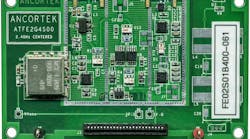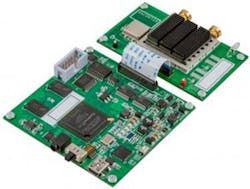System designers visiting the 2018 IMS exhibition found at least one company booth with something that made their lives much easier: Ancortek (booth 2316) was showing its low-power radio modules based on software-defined-radio (SDR) technology. Available for S-, C-, X-, and K-band frequencies, these compact modules (see figure) can cover wide bandwidths for numerous applications, including communications, monitoring, and radar systems. They include the essential components for a radio that’s operated under software control for ease of modifications.
This compact SDR radio module can be supplied for use at various bandwidths at S-, C-, X-, and K-band frequencies. (Courtesy of Ancortek Inc.)
The SDR modules operate on a single +5-V dc power supply, with SMA connectors for antennas, and a 24-pin FFC cable connection between the RF module and the processor module in a full system. The modules provide automatic correction of nonlinearities in a radio’s voltage-controlled oscillator (VCO), but maintain low power consumption. They can work with a variety of waveforms, including continuous-wave (CW), frequency-modulated-CW (FMCW), and frequency-shift-keying (FSK) waveforms. In the SDR form, the modules can quickly change their operating modes, waveforms, and bandwidths for use in multiple-purpose applications.
The firm also displayed its SDR System Evaluation Kits, which are basically starting points for Doppler radar system designers. They include the essential transmit and receive functions for a radar and are implemented with fractional-N phased-lock-loop (PLL) frequency synthesizers for linear tuning. Kits are available with dual receiver channels for advanced radar system designs. Each kit includes an RF module, a processor module, an ac-dc power converter that supplied as much as 3 A at +5 V dc, a copy of the SDR graphical-user-interface (GUI) software, antennas, cable, and an enclosure.


